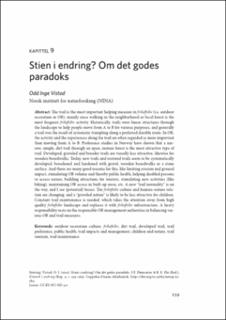| dc.description.abstract | The trail is the most important helping measure in friluftsliv (i.e. outdoor recreation or OR), mainly since walking in the neighborhood or local forest is the most frequent friluftsliv activity. Historically, trails were linear structures through the landscape to help people move from A to B for various purposes, and generally a trail was the result of systematic trampling along a preferred durable route. In OR, the activity and the experiences along the trail are often regarded as more important than moving from A to B. Preference studies in Norway have shown that a narrow, simple, dirt trail through an open, mature forest is the most attractive type of trail. Developed, graveled and broader trails are visually less attractive, likewise for wooden boardwalks. Today, new trails and restored trails seem to be systematically developed, broadened and hardened with gravel, wooden boardwalks or a stone surface. And there are many good reasons for this, like limiting erosion and ground impact, stimulating OR volume and thereby public health, helping disabled persons to access nature, building attractions for tourists, stimulating new activities (like biking), maintaining OR access in built-up areas, etc. A new “trail normality” is on the way, and I see (potential) losses: The friluftsliv culture and human–nature relation are changing, and a “graveled nature” is likely to be less attractive for children. Constant trail maintenance is needed, which takes the attention away from high quality friluftsliv landscape and replaces it with friluftsliv infrastructure. A heavy responsibility rests on the responsible OR management authorities in balancing various OR and trail measures. outdoor recreation culture, friluftsliv, dirt trail, developed trail, trail preference, public health, trail impacts and management, children and nature, trail tourism, trail maintenance | en_US |

